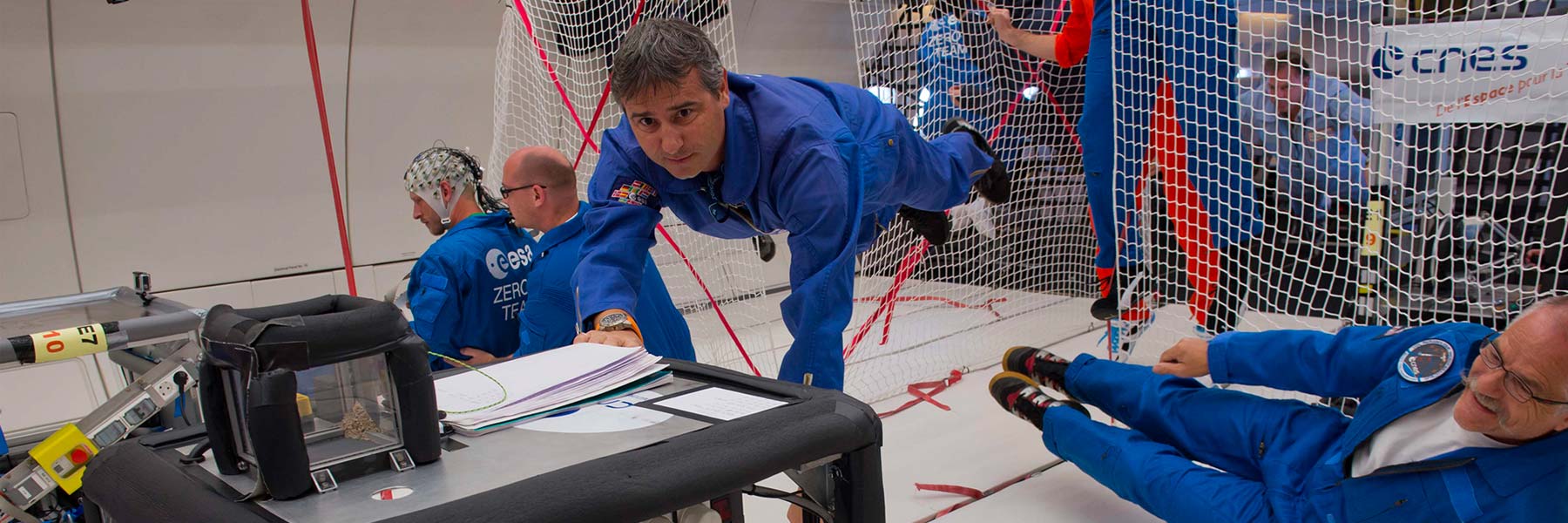Scientific research flights
Novespace’s main activity is to organise scientific parabolic flights for research in microgravity on the Airbus A310 Zero G – our flying laboratory. These scientific flight campaigns have been operated for many years.
Novespace’s main activity is to organise scientific parabolic flights for research in microgravity on the Airbus A310 Zero G – our flying laboratory. These scientific flight campaigns have been operated for many years.
Microgravity is a unique environment for the study of physical, biological and chemical phenomena usually masked or modified by Earth’s gravity, and for conducting experiments in a variety of scientific fields.
The work carried out by scientists in microgravity enhances fundamental knowledge in various disciplines, with innovative applications in the fields of technology, industrial processes and medicine.
Research in microgravity can only be carried out on Earth-orbiting space stations or vehicles, probe rockets and capsules, aircraft operating parabolic flights, or inside drop towers. Called “microgravity platforms”, each offers a different level of microgravity quality and duration.

| Advantages | Disadvantages | |
|---|---|---|
| Drop towers |
|
|
| Rocket probes and capsules |
|
|
| Aircraft |
|
|
| Space station |
|
|
Although short periods of microgravity, of around 22 consecutive seconds, are reproduced during each parabola in parabolic flight, their repetition makes it possible to accumulate a total weightlessness time of more than 10 minutes per scientific flight, and more than 30 minutes per campaign (standard missions).
Twenty-two seconds of microgravity allows users to study a very wide range of phenomena that occur immediately or after a few seconds of microgravity, and do not require long periods of weightlessness to be studied and characterized. The range of these phenomena is wide, covering many scientific disciplines.
Parabolic flights are an ideal platform for various purposes:
Novespace offers users different scientific mission profiles.
Standard missions consisting of three flights of thirty parabolas each with one flight a day. However, Novespace may group, on the same standard mission, several users sharing the aircraft’s resources and the costs of the mission. The ESA, CNES and DLR may take part in the same campaign, for example. Up to forty or so researchers may perform some fifteen onboard experiments on this type of mission.
Special flights, on which the single user chooses the number of flights and each flight’s length and profile. Flights can be operated from Bordeaux or any other airport in the world.
The Airbus A310 Zero G has the largest experiment surface area in the world. With a floor area of 100 m2 and a volume of 200 m3, it can accommodate 10 to 15 experiments per flight, and 40 investigators. It is fully padded and has floor fixing rails for experiments. Safety nets and straps are available. Video equipment can be attached to the side handrails.
The experiment area is lit with LEDs (light-emitting diodes) on the ceiling. The color temperature of the light is around 4,000 K and the illumination is approximately 600 lux.
Power supply
Electrical power is distributed by electric panels delivering 230 V-AC / 50 Hz which supply 8 to 14 A.
Venting system
Four external air connections are available in the cabin for manual or automatic venting.
Flight data recording
A report on in-flight acceleration recordings is available for investigators upon landing.
Novespace makes the know-how and experience of its engineers available to research teams applying for parabolic flight. They provide investigators with support during the experiment development phases including design, construction, testing and validation, and flight preparation. Contacts are made remotely by email, telephone, videoconference, and on-site (visits by engineers to labs and investigators to Novespace’s premises).
During campaigns, ground maintenance technicians handle the reception, boarding, onboard installation and disembarkation of scientific experiments. A manager is assigned to providing logistical and administrative support.
Easy to access, Novespace’s facilities at Bordeaux-Mérignac airport (France) have restricted entry. Novespace’s premises and technical resources are made available to scientific teams during flight campaigns. They include meeting and briefing rooms; a hangar to prepare for the experiment flight, including a workstation for each team; a laboratory equipped for handling hazardous products. Compressed air cylinders are provided.
The experiments are loaded onto the aircraft using a loading lift vehicle. Investigators and participants are loaned a flight suit.